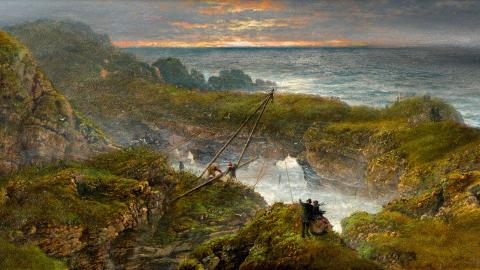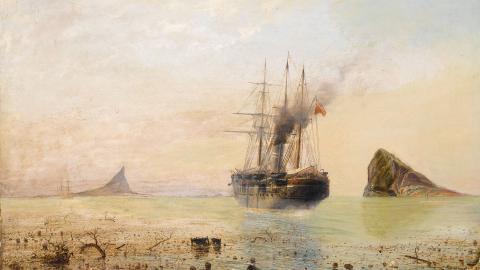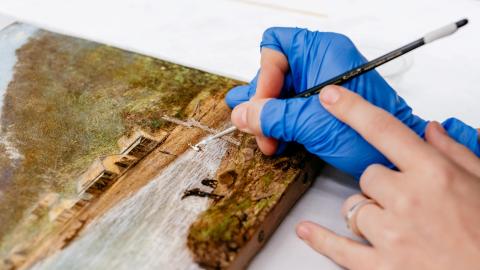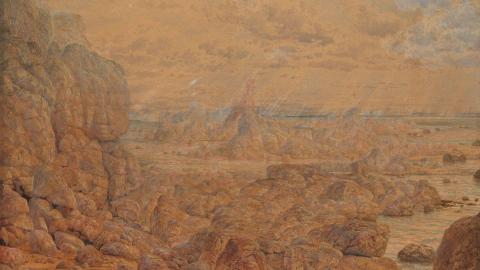Developments in the study of geology — the science of the earth — gained wide publicity in the popular press of the nineteenth century and affected the way artists depicted the landscape. British artists like Isaac Walter Jenner became increasingly acquainted with geological concepts, which in turn changed the way these artists looked at and painted the structures of the natural landscape. The sublime has long been understood to mean a quality of greatness or grandeur that inspires awe and wonder. As scientific investigation opened up fresh insights on time, space and existence — previously unfathomable concepts that both enthralled and astonished — this new language of geology expanded artists’ repertoire for evoking the sublime.
One of the most important elements of this new study was geological time — a concept that generated considerable debate, challenging traditional religious theories about the origins of the earth. In 1830–33, geologist Charles Lyell, in his Principles of Geology, set forth the theory of uniformitarianism; Lyell hypothesised that the earth formed slowly and uniformly over eons, a process of forces still in action. This challenged the scientific accuracy of the biblical account of creation.
After Jenner’s time in the Royal Navy (1855–65), he began working as a landscape and marine artist in Brighton. There, he painted a series of coastal views of eroded rocks and cliff strata studies, clearly influenced by discussion of these new scientific theories. In Ship aground, Cornwall Coast c.1870s, Jenner paints the imposing face of coastal cliffs, where layers of strata mark epochs of geological time. The grounded ship and figures play a pivotal role in the composition — their diminutive size aggrandises the vast height of the cliffs, while the field strewn with boulders in the foreground and the receding ocean suggest the relentless motion of the sea, slowly eroding the cliffs. These were all conventions used by artists to convey the sublime: insignificant human figures and shipd seen against nature’s imposing might.
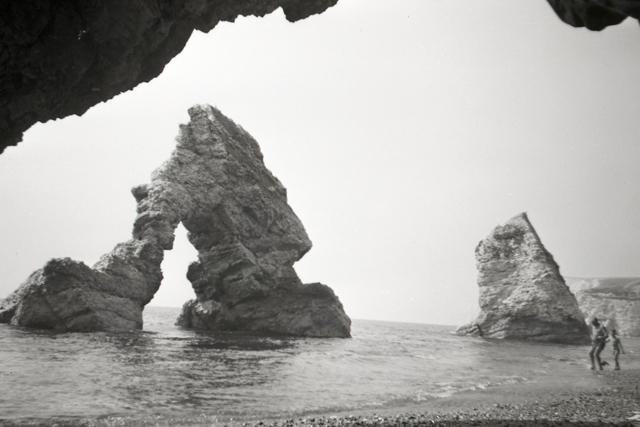
Ian Taylor / Arched & Stag Rocks, Freshwater Bay 1964 / Courtesy and © Ian Taylor/cc-by-sa/2.0
For Arched Rock c.1876, Jenner chose a well-known geological subject: a famous sedimentary landmark (seen above, photographed nearly 100 years later) in Freshwater Bay on the western side of the Isle of Wight. Popular with holiday-makers, the Isle of Wight lies south of Portsmouth, which was Jenner’s base while serving in the Navy. Admiring rock formations became a fashionable pastime for Victorian leisure-seekers; excursions to imposing, interesting and unusual forms were organised to ponder not just their beauty but also their scientific age and creation. This painting shows detailed sedimentary layers of chalk, a brittle form of limestone subject to erosion. Jenner plays with scale in the composition, incorporating tiny boats and human activity in the background. He captures the sedimentary structure of the natural formation in the minutest detail, conveying the sublime by contrasting ephemeral activity against the imposing grandeur of nature. The cliff face of which the arch was originally a part is seen in the background, with more sea-worn rock fragments in the painting’s foreground. The edifice and cliffs are framed by a clouded sky and flat tidal shoreline, which emphasise their monumental presence. Arched Rock finally succumbed to the elements and collapsed on 25 October 1992.

Although his primary medium was oil, Jenner was also an accomplished watercolourist, and taught and exhibited in both. Serpentine rocks, Scilly Isles, Lands End, England 1895 is a fine example, with its interesting use of watercolour and coloured chalk highlights. (Serpentine rock refers not to a particular location but rather a type of rock with the scaly texture of snakeskin, used extensively in building at the time for decorative purposes.) Intriguingly, Jenner has concentrated on the rock formations, backed by sea and sky with no human elements to enhance its scale. He painted this watercolour in Brisbane, despite it being an English subject, as a wedding present for one of his daughters, relying on sketches, drawing notes and memory to create it.
In capturing geological features in his landscapes — and often contrasting these against humankind’s relative insignificance — Jenner enhances our experience of the romantic sublime. His careful rendering of these physical features adds a final sublime element, engendered by his understanding of the infinite age of the Earth.
Michael Hawker is Curator, Australian Art at QAGOMA.
Explore ‘A Feeling For Light’

Digital Story Introduction
ISAAC WALTER JENNERIsaac Walter Jenner: Curating a feeling for light
Read ESSAYDigital story context and navigation
ISAAC WALTER JENNERExplore the story

